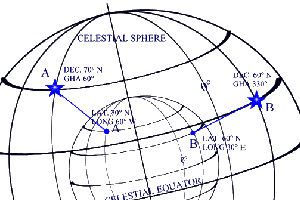 Earth's coordinates and the Celestial SphereI’m dusting off the plastic tub where I keep all the materials for my Celestial Navigation class, in preparation for teaching it again, starting March 4. It’s not a certification course for learning how not to get lost at sea, but an introduction to astronomy spun up with the theme of that ancient practical use for astronomy.
Earth's coordinates and the Celestial SphereI’m dusting off the plastic tub where I keep all the materials for my Celestial Navigation class, in preparation for teaching it again, starting March 4. It’s not a certification course for learning how not to get lost at sea, but an introduction to astronomy spun up with the theme of that ancient practical use for astronomy.
Though I’ve been teaching this subject since 1996, I was delighted to run across a pair of antique sextants purchased in the 1940s by Earle Linsley, Chabot’s second director, for use in his Celestial Navigation class!
Anyway, it’s a special topic for me as it blends my interest in astronomy with my long time fascination for things nautical: ships, exploration, adventure, and global geometry.
Fixing one’s position on Earth is one of the oldest practical applications of on-the-go astronomy (maybe not as old as working out the seasons and establishing standard periods of time—calendars—but possibly a contemporary craft). Long have sea-faring cultures in the Northern Hemisphere used Polaris to mark north and determine latitude. In the Southern Hemisphere, without the trusty North Star in view, navigators such as Pacific Islanders crossing that vastness in large canoes nevertheless memorized the locations of other stars at different times of the night and year to steer their courses from island to island.
Arab caravans crossing the Sahara desert used Celestial Navigation so as not to get lost on the endless waves of sand dunes. The astrolabe—an instrument used to measure star altitudes to help plot position—was developed originally by Arab desert caravan drivers, not for sea-faring ships!
